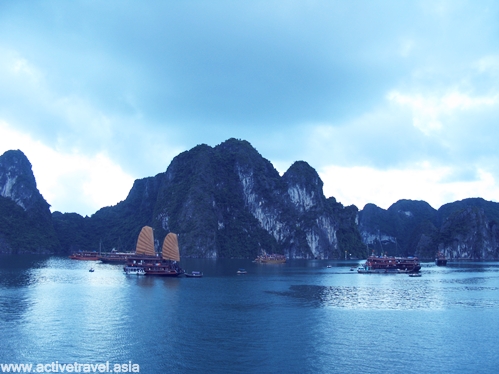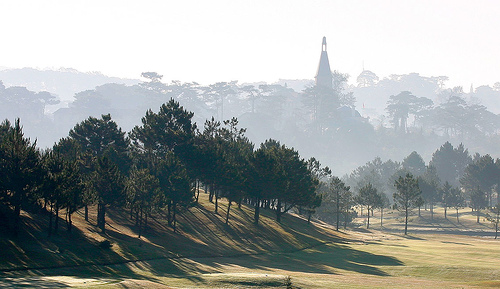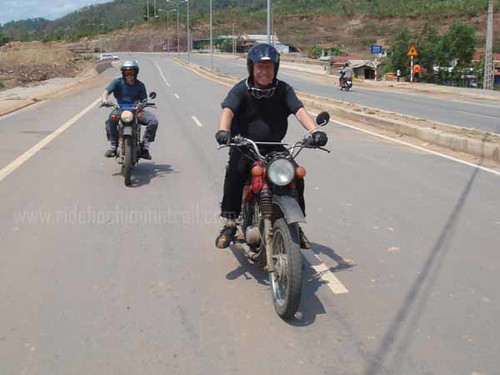Continue with Red Spider Group motorcycling 16-day in Vietnam. This entry told their days in the centre and centre highland of Vietnam. Let check it out!
Saturday January 23rd
Today was a day of many experiences. We rode from Dong Ha to A Luoi, via Khe Sanh, the famous and deadly USA base in the mountains of mid Vietnam just south of the DMZ. We started our ride in a shower, then a steady rain and then a downpour. Clearly today was our most challenging ride of the trip in terms of the weather.

Ethnic people village, Khe Sanh, Vietnam
We arrived Khe Sanh after a long and wet ride. All of us recall the name Khe Sanh, one of the toughest and worst places for any soldier of either side during the VN war. The ride up was steep, cold and wet. Upon arrival the sun came out and at least started to dry out those of us who did not have rain gear. We visited the war museum there. It had an impression on all of us but probably Bruce Wingman the most. We saw the Huey helicopters like the one Bruce Wingman Gouldsberry jumped out of and we saw pictures and stories at the museum that were heartbreaking.


Khe Sanh, Vietnam
One of the most disturbing things was the locals peddling the dog tags of American, British and Australian servicemen who lost their lives in the place commonly referred to as HELL. While the people we have met along the way so far could not have been nicer or more friendly, to see the dog tags of our lost troops being sold as meaningless pieces of metal was disturbing to all of us. Several of us bought tags, only to get them and find the rightful owners.
After the visit to Khe Sanh, we headed back across the mountains again for about another 100 KM's. The weather improved and was dry and we followed a beautiful river the entire way through winding roads and spectacular views of a river valley that was simply stunning. We visited an ethnic village and were greeted....as we have been all week, by very friendly people. Interesting contrasts of poverty, but satellite dishes for TV viewing. We had earlier in the day decided on a picnic lunch....much to the dismay of our Vietnamese team. We stopped by a bridge and enjoyed bread, peanut butter, cheese and mandarin oranges washed down with freshly made coffee.

contrasts of poverty, but satellite dishes for TV viewing
We continued our travels to the east south east for the balance of the day and made it to A Luoi around 4:30 in the pouring rain after another day of roughly 200 KM's of riding.
Tomorrow we head for Hội An, on the coast in mid Vietnam. And we are hoping for a dry day!!
Sunday January 24th
Today we start day 6 of our 10 day ride and we are headed for Hội An on the coast just south of the DMZ and near Da Nang. Our 240 KM trip gives us a total now of about 1,100KM's or about half, give or take, of our 2,200KM trip. Today's ride was advertised as "the most beautiful ride of the trip" and we must say it lived up to that while at the same time being quite an experience and very challenging at times as you will see in the videos and pix.

Beautiful day on road to Hoi An, Vietnam
In the morning we headed out of A Luoi under a partly cloudy sky which was a relief after the two days of rain. but as we drove into the mountains the slight fog, turned into a huge fog and visibility went down to about 1 tenth mile at many points. We were climbing, climbing, climbing up the mountains but beyond the guardrails we could see nothing but fog. We knew it was a long way down and the view spectacular but no dice.....could not see a darn thing. Going was slow in the fog and the moist winding roads. To top it off, we ran into several landslides which had totally wiped out the normal road and passing was through a mass of mud and debris. Actually running the bikes through the mud as you will see in videos was a quite a lot of fun....and we did not lose anyone down the mountain in the process.
It was slow going and then about noon the sun burst through the fog and lit up a mountain landscape in a half dozen colors of green. The views were spectacular and the ride for the rest of the day was indeed the best we have had....just a bit better than yesterday. We followed several rivers up and down through the mountains for several hours and went through a number of landslide areas, to frequent to count. Some easier than others but overall some impressive sights.

Hoi An hotel, Vietnam
We stopped in Thang My for a lunch of Noodles at one of Kenny's (our guide) favorite restaurants. Then we made it into Hội An which is a major coastal city and a major tourist area. For the first time since we left Hanoi on Tuesday we saw other westerners and, to be honest, we did not like it. We have enjoyed our adventure in the absence of the normal tourist trappings and to see the touristy Hội An was a bit of a shock to our systems. We took our weeks worth of clothes to the laundry across from the hotel and headed out for dinner. There were many options and this is clearly the best area for dinners we have seen in a week and we enjoyed it very much.
The really big news for tonight is that we will get our laundry done!!!! Tomorrow we head for Khum Doc and a short ride of about 190 KM's.
Monday January 25th
Today we left Hội An, a beautiful port city and headed for Kham Duc a small city in the mountains. Our ride today was about 180 KM's so rather short compared to several recently. Weather excellent today, sunny and puffy clouds to cool us from time to time. Overall, we would say today was the least interesting of the trip....other than the drive through Hội An and several other cities where our driving skills were tested to the max dodging bikes, trucks, people, road muffins, cattle, and you name it.

My Son, Vietnam
Our first stop were the ruins at My Son where in ancient times the Cham dynasty lived and built all sorts of temples to honor their Hindu god Shiva. After the visit to the ruins we headed south to Kham Doc for a nice ride in the foothills and lower portion of the mountains. There is a massive dam and road relocation project on going in this area so the biking was challenging again at times much like the mud of yesterday but now gravel.....which is actually lots tougher to drive on. But we all made it with no problems.
Kenny took us to the usual local restaurant for lunch and we hit Kham Doc about 4 PM just in time for a cold beer.
Kenny taking us out for some local food tonight....just like most nights. We hear that we are having venison tonight, and maybe a little pooch on the side!!
So stay tuned and we will keep you up to date. Tomorrow we head about 250 KM's straight south along the Cambodian border to Kon Tum. Should be a nice ride if the weather stays nice.
Tuesday January 26th
Greetings followers of the Red Spider Vietnam Bike Trip. A couple statistics to catch you up on. Today, Tuesday finished our 8th day of riding. We have traveled just short of 1,400KM's since leaving Hanoi. We are about 1,400 KM's from Ho Chi Minh City. We have two days of biking remaining that will cover about 500 KM's. The last part is our one hour flight from Nha Trang to HCMC on Friday mid day. The trip has been awesome overall and everyone has enjoyed it.

Dave & waterfall
Another couple of statistics. We have been having an ongoing 31 Card Tournament and so far Bruce has won 3 matches, Kenny one and Bill one. The Burrows brothers have bowed out early in each round. A match is worth $120.00. Also, our room situation is that there are 5 travelers and three rooms. This means that each night somebody gets a single and the others share rooms. That contest is decided nightly by a cut of the cards and so far Bruce has two wins....including one super suite with a Jacuzzi. So on the side games, Bruce is clearly in the lead......but we have a few days left.
Today was two days built into one. We awoke in Kham Doc with a downpour. It had been raining since about midnight. Our trusted guide Kenny assured us that our rain would only be on the west side of the mountains where we were and as soon as we got on the east side of the mountains, it would be sunny. So off we went, in our rain gear headed for Kon Tum.
We traveled in the mountains, with a steady rain, a foggy mist and everything looked like a place where King Kong would step out at any minute. In spite of the rain, we enjoyed the ride, beautiful waterfalls and lush jungles on all sides.
Then as we passed over the tops of the mountains, just as Kenny said, the skies cleared the sun came out and the temperature warmed considerably. We shed our rain gear and into our short sleeve shirts and away we went. Not only did the sun shine, but we actually went from a tropical jungle environment into a desert. It became very dry and dusty and much like the area like southern California around Palm Springs.
In this area we went through a long area where the infamous Agent Orange was clearly used. Across the mountains in nearly all directions we could see areas that are still bare with the exception of a bit of grass. Old dead trees dot the landscape in these areas. And, to compound the initial damage that Agent Orange did, the new problem created is that these large barren areas cannot stand up against the rain and therefore collapse into a landslide very easily. Throughout this part of our trip we saw many new landslides like a few days before, but at least this time we did not need to bike our way through mud.
After a nice lunch of BBQ we motored down the road and headed for Dac To, a location where one of the worst battles in the war took place. Hundreds of US soldiers were killed, more than 30 planes shot down and thousands of South Vietnamese solders were also killed. No telling how many soldiers from the North were killed. We paid our respects at the memorial and headed for our final destination Kon Tum.
In Kon Tum we arrived about 3pm, so we had time to go to the Banhar ethnic village and to a Catholic Church and Orphanage. We met with the headmaster of the orphanage and school and saw many happy kids there.
After this, we had just enough time to go to a sidewalk cafe and enjoy a cold one or two as the sun set over Kon Tum. Enjoy the video and pix for the day and wish us well on our next phase of the trip, a long ride of +240 KM's for our Wednesday to the next city which is Buon Ma Thuot.
Source: peterb.yolasite.com
Vietnam Motorcycling recommendation:
Motorcycling travel guides
Motorcycling tours in Vietnam
 Market floating in Mekong Delta, Vietnam
Market floating in Mekong Delta, Vietnam




















